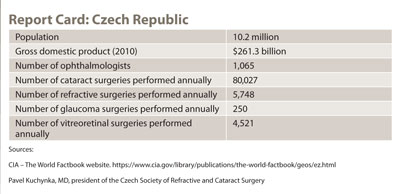Changes in Czech health care system provide accessibility, quality of care
Hospitals in the Czech Republic are outfitted with the best equipment, but physicians work on limited budgets.
Click Here to Manage Email Alerts
 Pavel Kuchynka |
An efficient network of services equally distributed within the national territory, a good ratio of ophthalmologists to patients and a high number of fully equipped eye hospitals make the Czech Republic a model for eye care among Eastern European countries.
“Between large and small hospitals, we have approximately 65 ophthalmology departments for 10 million inhabitants. In addition, a large number of outpatient clinics are evenly distributed throughout the national territory,” Pavel Kuchynka, MD, president of the Czech Society of Refractive and Cataract Surgery (Èeská Spoleènost Refrakèní a Kataraktové Chirurgie) and OSN Europe Edition Editorial Board Member, said.
With a population of 1 million, Prague has three university hospitals, one military hospital and two large city hospitals. All are adequately staffed, well-organized and fully equipped with cutting-edge technology, Dr. Kuchynka said.
“We are top-level for equipment in some departments. We have three femtosecond lasers in Prague, with all the facilities for refractive surgery. IOLs are standard, but patients can pay extra to have premium lenses implanted on hospital premises. We are provided with the best devices, medications and equipment,” he said. “This allows us to offer higher levels of care than most Eastern European countries.”
Reimbursement issues
Ophthalmologists in the Czech Republic receive inadequate reimbursement for their services, according to Dr. Kuchynka.
“A lot of the money given to the health sector goes into maintaining hospital buildings and providing facilities and equipment, while doctors work with low budgets,” he said.
After the fall of the Berlin Wall in 1989, the democratization process in Eastern Europe opened the door to a new system of health care financing. Czech citizens now pay mandatory contributions to one of the nine insurance companies approved by the government and are entitled to free medical services for standard procedures. Reimbursement is provided on a fee-for-service basis. Physicians in both the public and private sectors sign contracts with the insurance companies and are reimbursed directly for services they provide to patients.
There are fixed rates for health care procedures.
“Rates have been several times amended by negotiations but remain low. Reimbursement for cataract is the equivalent of US$350 to US$400, including the IOL,” Dr. Kuchynka said.
Fees for private procedures are proportionally low. Refractive surgery, paid for by patients out-of-pocket, costs US$700 per eye, far less than in any Western European country.
 |
Liberalization of the health care system in the Czech Republic has introduced the principle of free choice in health care facilities. Patients can choose where to go for their consultations and treatments and are reimbursed by the insurance companies regardless of the location, Dr. Kuchynka said. Patients are required to obtain a referral from a primary physician in order to visit a specialist.
For physicians, liberalization has granted them the right not only to private practice, but also to dual practice in the public and private sectors.
“Many of us integrate [our] hospital work with something like two half days in a private practice,” Dr. Kuchynka said.
New opportunities
Not all ophthalmologists in the Czech Republic are trained to become surgeons. Most students receive only general ophthalmic training and work exclusively in ambulatory settings. Of 1,065 ophthalmologists in the country, approximately 160 are surgeons.
“We are developing new residency programs in ophthalmology within university hospitals. Ophthalmology has made giant steps in our country in the last 10 years, and there are now more opportunities for those who are interested in specializing as surgeons,” Dr. Kuchynka said.
More than 70% of ophthalmologists are women, an amount that will continue to rise in light of current medical school enrollment rates.
The former Czechoslovakia imposed heavy limitations on its citizens’ freedom of movement. Now that physical boundaries no longer limit travel for Czech citizens, ophthalmic specialists are gradually expanding international collaboration and intellectual exchange.
“A lot is organized internally in terms of courses and seminars,” Dr. Kuchynka said. “We have quite an intensive professional exchange with specialists from Western Europe and also Eastern European countries. Our presence in international meetings is also growing, although our income and exchange rate are a limitation.”
The choice of Prague as the site of the 2012 winter meeting of the European Society of Cataract and Refractive Surgeons has been welcomed as an opportunity for a large number of ophthalmologists to share experiences with their international colleagues and discuss issues with leading experts. – by Michela Cimberle

- Pavel Kuchynka, MD, can be reached at Srobarova 50, 100 34 Prague 10, Czech Republic; +42-0-267-162-390; fax: +42-0-267-162-491; email: kuchynka@fnkv.cz.
- Disclosure: No products or companies are mentioned that would require financial disclosure.
